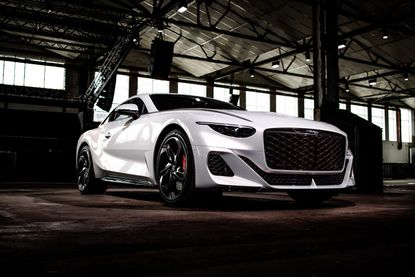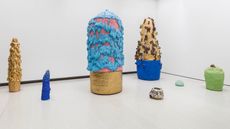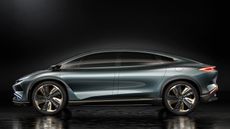Bentley Mulliner Batur is a ‘revolution’ for the brand, says director of design Andreas Mindt
The Bentley Batur is the ultimate expression of Bentley’s Mulliner division, a majestic two-door car that could light the way to an all-electric future
- (opens in new tab)
- (opens in new tab)
- (opens in new tab)
- Sign up to our newsletter Newsletter

The Bentley Mulliner Batur is a significant motor car for the brand, in that this two-door grand touring coupé premiers the marque’s future design in the post-combustion age. The name references Lake Batur, the natural body of water in Kintamani, Bali. Only 18 examples of the £1.65 million car will be built, with each individually crafted in the company's Mulliner coachbuilding division, where customers can select materials, colours and textures from a wide catalogue specific to the car.

Bentley Mulliner Batur (credit: Uncovered)
Mulliner Batur explores some interesting, ecological materials for Bentley. This includes a high-performance composite made from flax as an alternative to carbon fibre, sustainably produced leathers and alternative textiles made from by-products of the coffee roasting process, and carpets crafted from recycled yarn.

The design may premier the electric future, yet the Mulliner Batur is the most powerful Bentley to date and one of the last cars to celebrate the 740PS version of the hand-assembled 6-litre twin-turbocharged W12 engine. We caught up with Bentley’s director of design, Andreas Mindt, to see what Batur means to the future of Bentley.
Andreas Mindt on Bentley Mulliner Batur

Wallpaper*: You refer to Batur as representing a revolution in design. How so?
Andreas Mindt: The design is clean and cool – cleaner than any car we have designed. To me, simplification of design and less decoration make it a revolution for us. Saying that, the revolution is driven by our history, building on the past while presenting a huge leap forward. I was inspired by the Continental Type R. It is beautiful because of its simplicity and lack of decoration. The design is purified. The car is a role model for me on how to design: if you begin with a great basic architecture, then the design process is simple.

Bentley Mulliner Batur (credit: Uncovered)
W*: Can you explain how this concept of purity is explored with Batur?
AM: Batur’s design principles are pure in appearance, clear, and easy to understand. For instance, the bonnet and body connection are kept clean and clear. The side view has a single line, with no others interrupting it. At the front, the upright elegance, essential to a Bentley, is more pronounced, so not only is the grille upright, but also the lights no longer lean back. For me, it creates an overall feeling that is pure. That’s the essence of what we’re doing with design.

Bentley Mulliner Batur (credit: Uncovered)
W*: Bentley has committed to full electrification. How do you respond to this with your work?
AM: We must deliver on sustainability in our direct and indirect actions. By direct, I mean what we’re doing in our design department, implementing some sustainable initiatives, such as using a recycling machine to reuse our clay. The indirect action is our cars, where we can use design to help deliver more energy-efficient products. When the cars are more aerodynamic and the product design is more effective, as in less decorative, the cars will naturally use less energy on the road.
W*: Mulliner cars, like this Batur, are crafted in limited numbers. The process is ultra-exclusive by nature. Do you see these elements – handcraft, the touch of humans, and rarity – as essential to the story of luxury for Bentley?
AM: Absolutely. The final element of sustainability is what happens when the products are at the end of their lifecycle. If the product has a specific value, you don’t need to throw it away. Type R, for instance, was also made in limited numbers – only 208 were built, with 206 in existence today for the cars to remain timeless. It’s a lovely symbol as nothing gets thrown away with the value constantly rising. Today, we still have a high share of vehicles that exist – something like 80 per cent I believe. The spare parts are also reused as they too hold a specific value.

W*: Inside Batur, you’ve created a warm and inviting space where colour and texture are used to almost cocoon the driver and passenger. Do you see this as vital as cars become increasingly cold and technical?
AM: It is necessary to give our customers the feeling of being connected to the environment and safe and supported in our cars. This is luxury. And the space must make you feel relaxed. Here the driver and passengers are wrapped around by beautiful materials, with colour playing a big part in creating this atmosphere. The top part is very dark; then we use extreme colours of oranges and reds to create a cosseted environment. Our heritage inspired us; the 1959 classic S2, for instance, had a beautiful curved wooden dashboard, which created a feeling of being cosseted inside.
W*: The Batur explores some interesting ecological materials options. You’ve spoken of your aim to work towards designing and developing carbon-neutral interiors. Can you speak of your goals?
AM: We are on a journey to be CO2-neutral with our interiors. This could mean labelling everything, every surface and element you touch and see inside the cars, to be transparent. Yet to achieve this isn’t easy. It means monitoring our suppliers and understanding the complete material choice, and the hidden elements. For instance, avoiding gluing in favour of screws saves a lot of energy and will help at the end of the car’s lifecycle.
We work closely with our suppliers to find materials that are right for our brand. Our customers have certain expectations, so we cannot always use certain fabrics. We use craftsmanship to beautify the materials – enhancing the look and feel to be truly luxurious. All of this takes time.

W*: The Mulliner collection cars are co-created with your customers. What is the process like?
AM: We offer our customers a huge choice of materials and colours to hyper-personalise their cars. And yes, we can guide them through the designs, but we also learn from them. When we do the Mulliner collection cars, we are often inspired by our collaboration with the customer. It really is a proper collaboration.
W*: What can you tell us about the future of Bentley design?
AM: We are constantly developing our ideas, looking to expand into new segments, body shapes and materials. But these ideas take a long time to develop. One exciting example is tweed, which we’re developing with our suppliers. You see, tweed is stiffer than leather, so you must simplify the shape where the material sits. It alters the design process with the material leading the shape, which can be exciting. It can also lead to simpler shapes. In our heritage cars, the carpets often led to simpler forms.

W*: How much of Batur’s design will lead the future?
AM: We have developed the core design principles and values with Batur, which we will take to our electric car. This is why this car is so important to us. We have now purified Bentley design which will take us to the next stage.
Bentley Motors, BentleyMotors.com (opens in new tab)
-
 Watch Ryuichi Sakamoto's mesmerising musical experience at the Brooklyn Museum
Watch Ryuichi Sakamoto's mesmerising musical experience at the Brooklyn MuseumAn iconic composer who traverses popular and high culture, Ryuichi Sakamoto pushes music into new frontiers, most recently in ‘Seeing Sound, Hearing Krug’, a new composition that pairs sound, flavour, light and texture
By David Graver • Published
-
 Last chance to see: ‘Strange Clay’ at The Hayward Gallery, London
Last chance to see: ‘Strange Clay’ at The Hayward Gallery, LondonAt London’s Hayward Gallery, group show ‘Strange Clay: Ceramics in Contemporary Art’ sees ceramic artists explore the physical, psychological, political and power of their medium
By Emily Steer • Published
-
 Aehra is Italy’s first all-electric luxury car brand. We preview its forthcoming SUV
Aehra is Italy’s first all-electric luxury car brand. We preview its forthcoming SUVAehra’s proposed electric SUV is brimming with cutting-edge technology. The Italian company hopes to shake up the high-end EV market in 2025
By Jonathan Bell • Published


